Lessons on Minimum Viable Products, Facebook and Google AdWords ads
My third semester at Tulane University has come to an end and there were more successes this semester than the previous two combined. I owe that to my efficiency teaching the subjects and pushing the students to take action faster, knowing how long it can take for ad approvals. I thought it would be helpful to share the results of the class’s group projects not just for your sake, dear reader, but also for mine, so I can have a recap I can reference for next semester.
The class I teach at Tulane’s A.B. Freeman School of Business is Marketing 4410, which is a lab associated with a social media marketing class. Truth be told, I don’t teach much about social media in the lab because I don’t know much about social media. I’ve never had success (or a desire, frankly) to grow a social media profile, amass Likes, friends and followers. Instead, I am lucky enough to be able to instruct the students on the lessons I’ve learned in my tenure as a Direct Response Marketer for a wide swath of companies domestic and abroad.
During the semester, I walk students through a logical process of reverse engineering sales funnels on popular websites, figuring out why and how marketers do what they do. Then, I instruct each student to write a report about a product, idea, message or service that they are passionate about. Some of the students are creative entrepreneurs with wonderful ideas, while others are more analytical, thinking of ways to marginally increase the success of something that already exists.
The students define a Minimum Viable Product for their idea and give it success criteria. For instance, one student this semester, Pablo, wanted to offer a full breakdown of the individual clothing articles actors and actresses wore in popular movies, allowing the reader the opportunity to purchase them. The cost of reviewing a movie, doing the research, then posting the information was outside of the scope of the class, but a Minimum Viable Product (MVP) could be achieved with little effort.
The problem so many entrepreneurs face when starting a new business is that they build their product or service in totality before they ask the market if there’s interest. This leads to enormous risks with product development costs, the entrepreneur going in a direction they think is right, instead of what buying customers say is right. Usually the outcome is a disaster, both in terms of poor sales and wasted effort. To thwart this potential problem, I instructed the students to answer the following question:
How many people need to say “I’m interested!” and give you their contact information for you to feel like your product or service will be purchased upon release?”
Some said 100, with the criteria being email addresses collected. Others wanted 200 Facebook Likes. Another student wanted 250 people in Turkey to take a survey. Each project had to have it’s own success criteria for a MVP. Then, the student drew out the immersion sequence; the individual steps a prospect has to go through in order to become a customer. Finally, the student brainstormed what traffic sources would be the most appropriate to acquire the visits that could then lead to sales and conversions.
A few weeks into the semester, the students turned in their reports. Out of the two sections, each with ~21 students, I chose 4-5 projects for groups to work on together. These were chosen based on their likelihood of success, minimal startup cost, and uniqueness.
Some of the projects that were chosen and rolled into Group Projects were:
- Gym Fit Pack – A multi-gym trial coupon, so you could find the right gym for you
- A French Patisserie in Turkey – The student who created this idea is a French citizen with Turkish roots. She wanted to figure out which city in Turkey would be hospitable and excited to have a French patisserie move in.
- High-end Sweatpants – Fashion meets function.
- Emergency Babysitter App – An application to find a last-minute sitter, similar to Uber and AirBNB
- Internet Marketing company in Belize – The student was a Belizean and wanted to create an internet marketing company back in Belize when she returned after graduation
- Plastrak – A credit card tracking system to help people find their lost or stolen credit cards
It wasn’t my intention to find ideas that were the most viable, instead, it was to find ideas that had the highest likelihood of getting decent consumer data on as quickly and efficiently as possible.
For Plastrak, the credit card tracking system, the intention was to collect email addresses from prospects who raised their hand to say they were interested. To do this, the process was simple: Google AdWords Display Network ads targeted to the ideal prospect, driven to a landing page that provides basic information and the opportunity to submit their email address.
Here is the Ad Group, inside the Plastrak campaign within Google AdWords:

The image below shows the two ads the students wrote. The goal in running two ads was to test the difference between them and see which performed better.
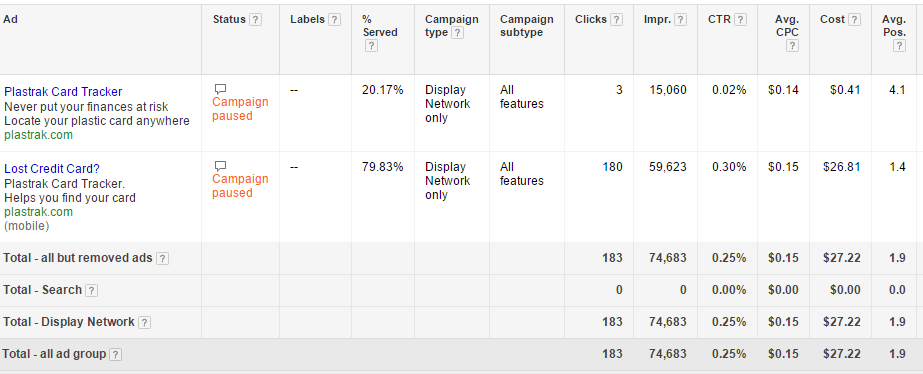
You can see the second ad was given nearly 80% of the impressions, assisted by Google to increase click-throughs. The average cost per click was $0.14-0.15, meaning that each time someone came to the Plastrak site, it cost us fifteen cents. We didn’t pay to display out ad, we only paid when it was clicked on. This is called Cost Per Click bidding, different from CPM or Cost Per Mil (thousand) impressions.
In total, the ads were displayed nearly 75,000 to qualified people as defined by the keywords on the webpages they were viewing. For instance, if someone was on a webpage about “credit card,” and that same page had a Google AdSense box, the Plastrak ad would potentially show. Below are the keywords used in the campaign:

The ads drove prospects to a simple page that the students created at Launchrock.co:

In total, there were 4 people who visited this page and submitted their email address. Four is a small number and although not nearly statistically significant, it is still a good indicator of what could possibly happen if we drove 10 or 100x more traffic.
The total cost, outside of time, to test out the Plastrak idea was:
- $12.99 for the Plastrak domain
- FREE for Launchrock landing page
- $27.22 for Google AdWords traffic
- TOTAL: $40.21
That’s only $10.05 a lead for the first market test. While it’s likely impossible Plastrak could become profitable paying over $10 a lead, that’s not the point. What matters here is that the students were able to test an idea and ask the market if they were interested. They could make an educated prediction that if they paid $10/lead and invested $1,000 in marketing, they could capture the email addresses of 100 interested, qualified prospects. From there, they’d have to sell them on the product and actually exchange payment. The numbers start to diminish from there: 1-3% sales conversion rate. They might make 1 to 3 sales for every thousand dollars they spend, assuming they’re not able to reduce the cost per lead, or increase the sales conversion rate.
To me, their idea is a wild success. They have proven it possible to drive qualified traffic and ask them for information in order to build a business. If they were truly interested in developing the product further, they would be in a better place by having done this MVP exercise.
Another group moved forward with the pack of gym passes, so a New Orleans resident could see which gym they liked the most. I think this really is a great idea, because it allows a gym to advertise for free, giving away something it already gives away – a single day to see if you like their setup. I know when I was choosing a gym in New Orleans, I spent a lot of time online, looking at pictures of the interior, reading reviews, then touring the different gyms. If I had a pack of passes I could take to 3-4 of my top choices, it would have made the process much easier.
Similar to Plastrak, this team decided they needed about 100 email addresses from people saying they were interested. However, because the idea is location-specific, they had to ensure the email addresses were for only the New Orleans area; specifically those who could likely travel to the gyms offered in the potential pack. Note that they students didn’t ask gyms anything, instead they wanted to see if there was interest first. If there was interest, they then had the opportunity to take those numbers to gym owners and ask for a partnership.
The ideal customer this group decided on was females over the age of 18-26 in the immediate vicinity. Because they wanted to target only women, they thought a Facebook ad would be the best route. Facebook has data points that Google AdWords simply does not. When my mom uses my laptop, Google doesn’t know it’s her, but when she logs into her Facebook account, Facebook knows who she is. For that reason, Facebook was the best platform for the initial test.
Below are the settings for the Facebook campaign:
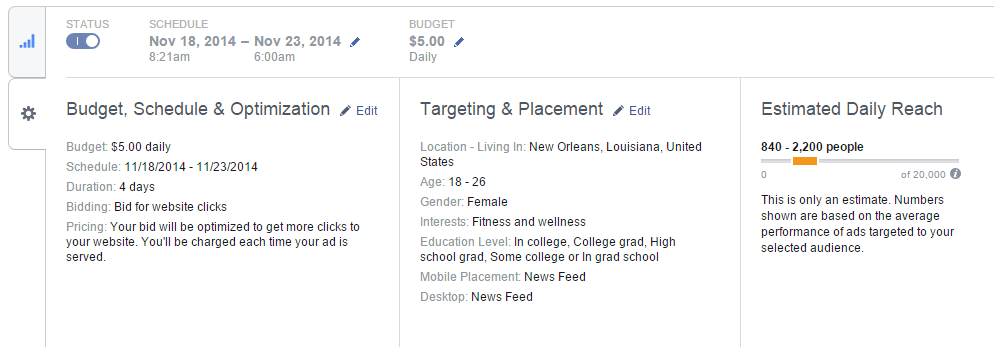
There were two different ad placements run for this campaign: the Newfeed and the right sidebar. On Facebook, you may be familiar with these two different placements for ads.
This is the Newsfeed ad. Notice the size of the image, the quantity of the content, the “Sign Up” button, etc. Much more engaging.
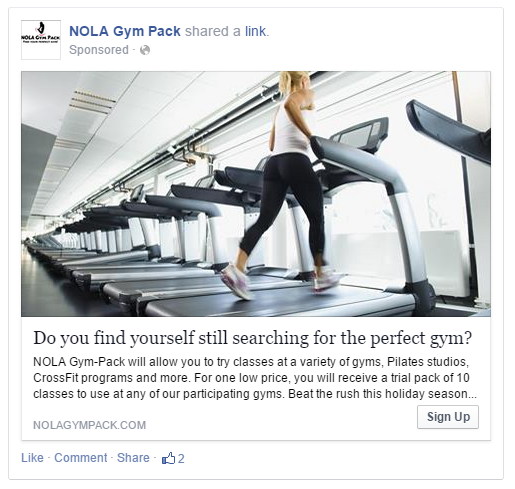
This is the right sidebar ad. Less content, no “Sign Up” button, smaller image. We can anticipate a lower CTR here.

Here’s the high-level of how they performed:
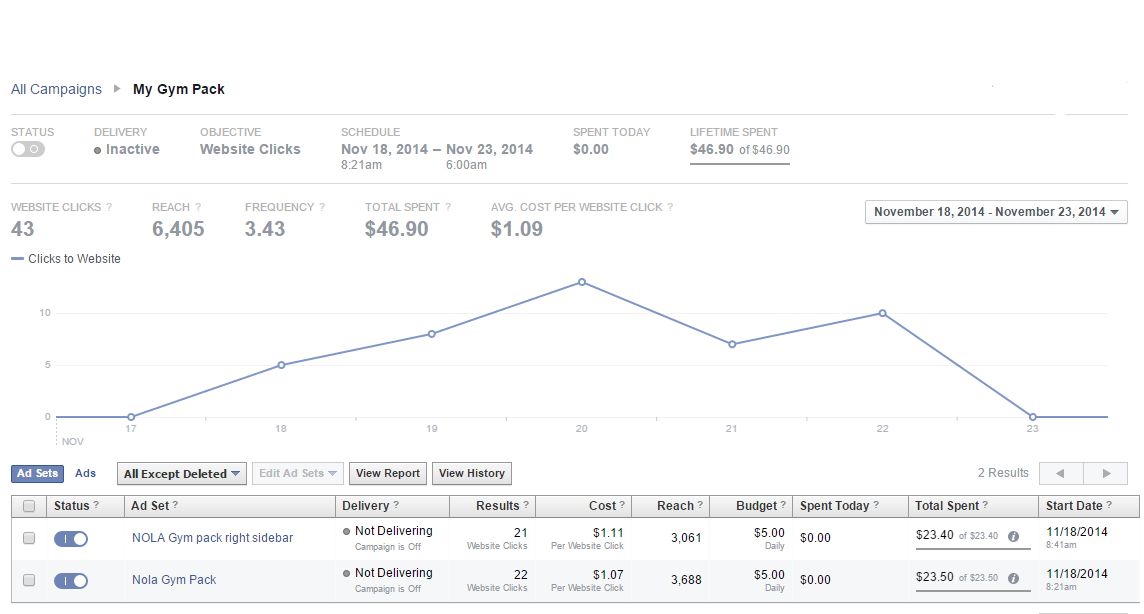
Cost per click was about the same for both placements: $1.07 vs. $1.11, with the Newsfeed being slightly more expensive. Click through rate (CTR) on the Newsfeed ad was 6.86% while the right sidebar was 5.97%. This mentally checks out for me because Newsfeed ads are much larger and more engaging than an ad to the side of the general feed of content I’m looking at.
This was the landing page the students created with Launchrock:
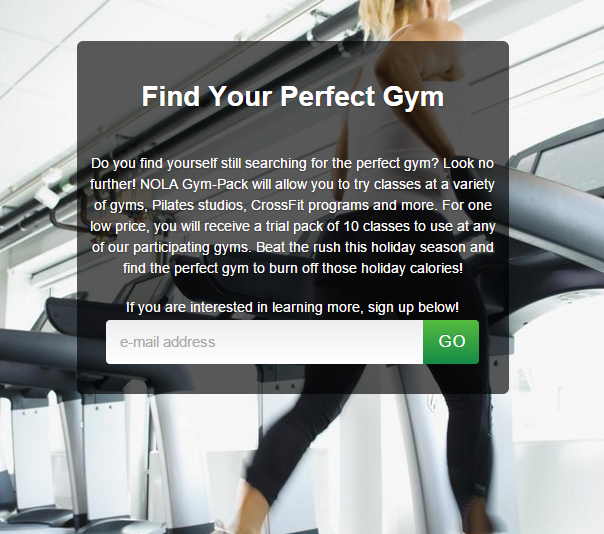
The total cost, outside of time, to test out My Gym Pack was:
- $12.99 for the MyGymPack domain
- FREE for Launchrock landing page
- $46.90 for targeted Facebook ads (both sidebar and Newsfeed)
- TOTAL: $59.89
There were a total of only 3 signups out of 43 visits. That’s a 6.98% conversion rate, at a cost-per-lead of $19.96. The lead cost here is nearly double what Plastrak was, which is interesting. The cost-per-click (per visitor) on Facebook was almost 10x what it was on Google AdWords Display Network, but the quality of the Facebook traffic made up for its higher pricepoint.
For me, this is a great reminder that getting a lower cost-per-click (CPC) on traffic is not necessarily an indication of the quality of the traffic. I’d rather spend $5 a lead and have them convert at 100% instead of spending $0.05/lead and only getting a 1% conversion rate. The quality of the data points Facebook has is far above any other mainstream advertising service, and is one reason I really love running ads on Facebook. While you’re paying more on the front end, you get the benefit of having a higher conversion rate, which means you can really choose the ideal prospect. Google AdWords Display Network is great for general products, and if you spend enough time tweaking and fine tuning things, you can get a Display Network campaign that is more efficient than a Facebook campaign… but it’s not easy.
The students are all set to graduate after next semester and did an extraordinary job mastering the content of the class. There were some significant wins that I witnessed, and some of the students are already taking what they internalized and are applying the lessons to the job hunting game. They’re all highly qualified young people who would be a benefit to any organization. If you’re a company looking to hire a young, but highly intelligent, self-starting junior level marketer, reach out to me and I’ll put you in touch with a few of them. They each have a paid campaign win under their belts, as well as a formal and applied understanding of direct response marketing.

